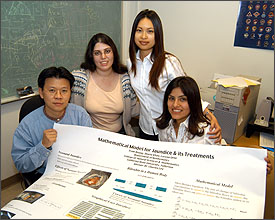
A Sick Baby Sparks a Father's
Research
by Dave Reid
From Dateline (March 27, 2003)
 |
Charles Lee, assistant professor of mathematics,
and students, from left, Shazia Khan, Tram Hoang and Lorena
Ortiz discuss their collaboration on a mathematical modeling
project dealing with the treatment of neonatal jaundice. The
project was inspired by Lee's son Preston, who was born one
month premature with the condition.
|
Unlike some mathematics research projects
that may deal with abstract concepts and complex theorems, Charles
Lee, assistant professor of mathematics, has been working on a research
project in which there was a tiny human face - the face of his son
Preston, who was born one month premature with neonatal jaundice.
Preston, now 4, and the mathematics research project
he inspired, may help doctors and parents deal with this ailment.
Already, the research has been accorded national and international
recognition.
Neonatal jaundice, which affects nearly two-thirds
of all preemies, is a condition that turns the skin yellow. Because
the baby's liver is not fully developed, it cannot process
the normal amount of bilirubin that then builds up in the bloodstream
and spreads to the body's surface, causing the skin, eyes
and inside lining of the mouth to appear yellow.
“It was scary for me and painful for the baby,”
said Lee, a member of the university faculty since 1999.
While Preston Lee was recovering, his father put on
his professor's hat and began developing a mathematical model
for the transport of bilirubin in the human body. The research has
been supported by an Undergraduate Research/Creative Support Initiative
provided through the Faculty Development Center.
Lee was aided in his research by math majors Shazia
Khan, Lorena Ortiz and Tram Hoang. Khan is now tutoring math and
science students at Chaffey Community College; Ortiz is a graduate
student, and Hoang will be graduating in May. Hoang was involved
in the research as a Ronald McNair Scholar.
The students, who normally deal with mathematics and
not medicine, did extensive research into medical and biomedical
areas, according to Lee, who earned his doctorate in applied mathematics
from UC Irvine. “I have been blessed with wonderful students,
and these are some of the best.”
Last December, the resulting research project won
the best paper award at the International Congress on Biological
and Medical Engineering in Singapore.
The student researchers also presented the project
at the national joint meeting of the American Mathematics Society
and the Mathematics Association of America in Baltimore. Hoang also
entered and won one of the top prizes in the March 11 CSUF Student
Research Competition. It will be entered in the systemwide contest
May 2-3 at Cal State Stanislaus.
In addition to the group presentations, Hoang gave
a poster presentation of the project at the Southern California
Research Day at Caltech. Khan presented the research at the 2002
Nebraska Conference for Undergraduate Women in Mathematics. Hoang
presented the findings March 14-15 at the National Conference on
Undergraduate Research at the University of Utah, where the paper
was selected for presentation from among 2,300 student abstracts
submitted.
In their mathematical model, the researchers incorporated
three treatments: blood transfusion (used in extreme cases); phototherapy,
in which the babies are bathed in light to bleach the bilirubin
in the skin and make it water-soluble; and medication.
“Our goal is to find, by observing the serum
bilirubin concentration, the optimal treatments to bring the concentration
of bilirubin down to a normal level,” said Lee.
“In short, our mathematical model for neonatal
jaundice, including its treatments, provides the fundamental tool
to investigate the effectiveness of individual treatments, a combination
of treatments, treatment starting times, severity of the condition,
and the rate of improvement of the liver, with or without breastfeeding,
etc.
“It also serves as a testing ground for new
treatment or new medication and can be adapted for other bioengineering
applications,” stated the researchers in their paper.
The findings, accompanied by charts and graphs, will
be submitted for publication.
« back to Research |